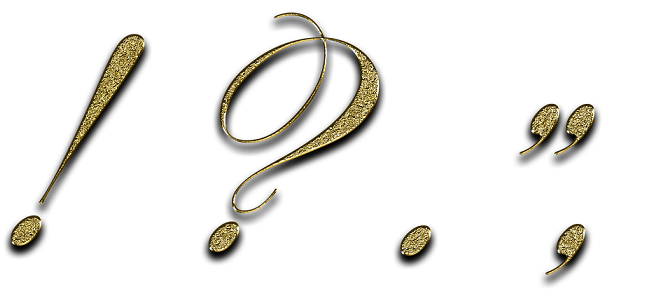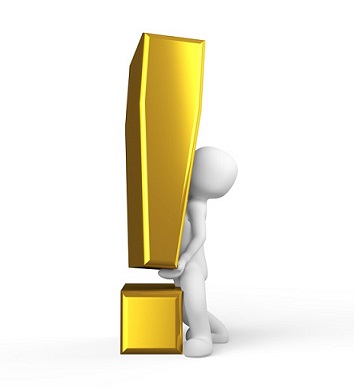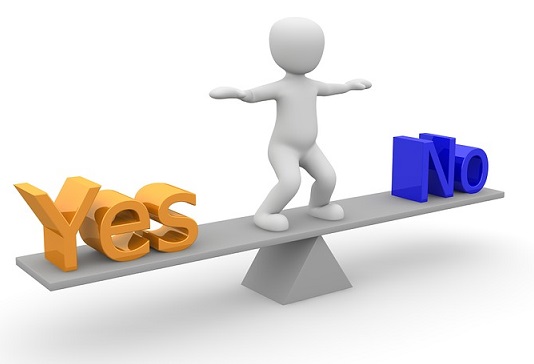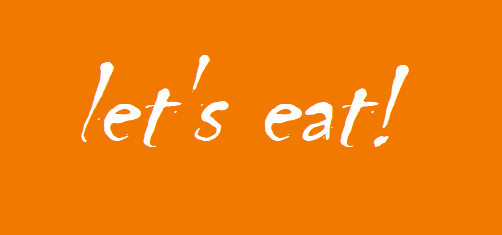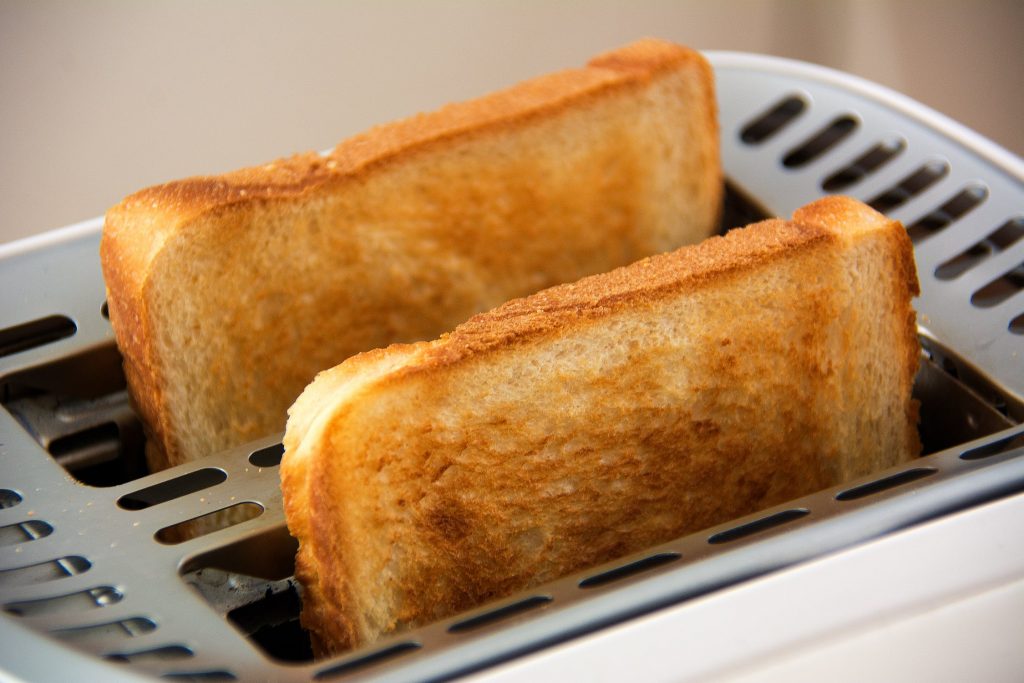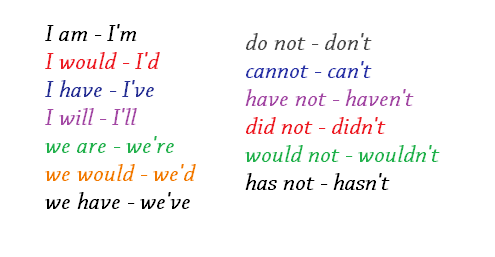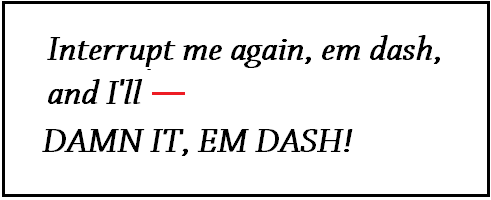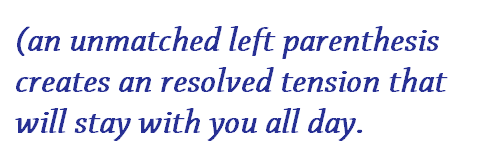 Punctuation in English
Punctuation in English
Punctuation helps organise the orthography or writing system of the language. It creates sense, aids clarity and gives stress to certain parts of a sentence.
EFL students will find it useful to know how to use punctuation in English, as it makes writing clearer and more natural. Proper punctuation can also make a huge difference to the meaning of a sentence.
For example, the following sentence reads differently depending on the punctuation used:
Eats shoots and leaves
Eat, shoots and leaves
Eats, Shoots and Leaves is the title of a famous book all about punctuation. The sentence without a comma reads as though an animal eats shoots (parts of a plant) and leaves (assumed here to be parts of a plant).
The second sentence with a comma implies the animal eats, then shoots something or someone with a gun, then leaves the scene (exits).
As you can see, knowing how to use punctuation in English can make an enormous difference!
English punctuation marks
The different punctuation marks in English are:
Full stop .
Comma ,
Colon :
Semi colon ;
Apostrophe ‘
Exclamation mark !
Question mark ?
Hyphen and Dash – and —
Parentheses or Brackets ( ) [ ]
Full stop
In English writing, the full stop is one of the most used punctuation marks. We use full stops to mark the end of sentences. For example:
We stayed in a hotel in Manchester. The rooms were big and the breakfast was delicious.
We also use full stops after initials and abbreviations. For example:
- Ms C. Jones
- Laura H. Clarke
- P. D. Samson
American English also tends to use full stops after titles. For example:
- Dr. Armitage
- Prof. Botting
- Mr. Cook
And after shortenings of words and Latin shortenings. For example:
- Dept. (department)
- Intl. (international)
- etc. (etcetera)
- e.g. (exempli gratia = for example)
- i.e. (id est = that is)
When learning how to use punctuation in English, the full stop is one of the first marks to learn – and one of the most useful. It is also used in many other languages for the same purposes.
Capital letters
We use capital letters in English to mark the first word of a sentence. A capital letter will nearly always be used after a full stop.
English also uses capital letters for proper nouns, such as names, titles, days of the week, months of the year, cities, counties, countries and holidays.
When learning how to use punctuation in English, students can find it difficult to know where to use a capital letter, depending on what they are used to from their native language.
For example, Spanish tends to use fewer capital letters. Spanish writing does not use capital letters for the days of the week or months of the year. In contrast, German uses more capital letters than English as it capitalises most nouns.
Exclamation mark
Exclamation marks are used instead of full stops to show a sentence is an exclamatory phrase. When using punctuation in English writing, we often use exclamation marks to show surprise, shock, happiness and other strong emotions.
Exclamation marks are also used to add emphasis, especially in informal writing. For example:
- Stop!
- Look!
- No! Wait for a minute and listen to this!
- The journey took five whole hours!
Question mark
Question marks are used after a sentence instead of a full stop to indicate a question. When learning how to use punctuation marks in English, students will be taught to add a question mark after an interrogative phrase.
For example:
- How are you?
- Did it rain last night?
- Yes. Did you take your raincoat?
- Have you seen the weather forecast? It says it will rain for seven days in a row!
- How many cakes did you eat? Do you think I baked too many?
- Which book did you read yesterday? Did you enjoy it?
- It was a great movie, wasn’t it?
Comma
The comma is a useful English punctuation mark and can be found in all types of writing. Commas are used in a sentence to offer a shorter pause than a full stop and to improve clarity of expression.
Commas for clarity
For example:
- She walked to the shop in a happy, relaxed and slightly philosophical mood.
- Petra, the English teacher, knew all the students.
- He prepared the food, always washing the vegetables thoroughly.
Commas for sense and meaning
Sometimes commas are not only important for clarity, they can change the whole meaning of a sentence. For example:
- Let’s eat, Thomas.
In the example above, “Lets eat, Thomas” the sentence suggests to Thomas that we eat. The comma is absolutely vital. Without the comma, it would read “Let’s eat Thomas” and this sentence would suggest to someone that we eat Thomas!
Commas for lists
English also uses commas to separate items in a list. British English does not usually use a comma before the ‘and’ introducing the last word in a list, unless the sentence would be unclear otherwise. American English does use a comma after the ‘and’.
For example:
- He bought bread, milk, eggs, potatoes and meat. (British English)
- He bought bread, milk, eggs, potatoes, and meat. (American English)
If a comma is used before the word ‘and’, it is called an Oxford comma.
Some people like to use a comma after the ‘and’ because otherwise the two ending items in a list could be misunderstood as being connected. For example:
- “I used to live with a student, an avid reader and a naturalist”.
This sentence could mean I lived with one person (the student) who was an avid reader and a naturalist But if we add the Oxford comma, for example:
- “I used to live with a student, an avid reader, and a naturalist”
The sentence now suggests I lived with three people: the student, the avid reader and the naturalist.
We might also mean there were two people: the student (who was the avid reader) and the second person (the nautralist). To make it clear that the student is the avid reader, we would need brackets, hyphens or an explanatory ‘who was’ along with the Oxford comma.
Lists can make commas necessary and still the sentence might be confusing. However, usually the context is sufficient to understand the true meaning. If a comma isn’t enough to clarify, sometimes we will need to rewrite the sentence in a different way.
Colon
In English punctuation, we use colons to introduce lists. For example:
There are three colours in the French flag: blue, red and white.
We also use colons to indicate a subtitle of a book, film or CD or to indicate a subdivision of a topic. For example:
- Middlemarch: A Study of Provincial Life
- Bryan Adams: The Best Of
- Physics: Mechanics
- English Queens: Elizabeth I
When using punctuation in English, we often use colons to introduce direct speech. For example:
- Then she said: “I hope you have a good trip”
- He commented: “It was a total waste of time”
- Before leaving, she added: “I’ll contact you about the meeting next week”
Semi-colon
When learning how to use punctuation in English, the semi-colon is perhaps the least understood punctuation mark.
We use semi-colons instead of full stops to separate two main clauses. In these cases, the clauses are related in meaning but are grammatically distinct. For example:
There are 50 different types of fruit available in the shop; apples are the most popular.
Semi-colons are normally only used in more formal writing. For informal, everyday writing, full stops and colons are more commonly used than semi-colons.
Quotation mark
Double quotation marks indicate speech in English. For example:
She said: “Please buy some eggs when you go to the market”
If a quotation occurs within another quotation, we can use single quotation marks. For example:
- “I was talking to my mum and she said: ‘Buy the eggs when you go to the market’ just before I put the phone down”.
It is also possible to use the quotation marks the other way around. Academic writing normally uses single quotation marks for quotations.
Single quotation marks can be used around titles of books. For example, ‘Harry Potter and the Philosopher’s Stone’. But we can also use italics instead: Harry Potter and the Philosopher’s Stone.
Single quotation marks are also used to emphasis a word and to imply there might be some ambiguity about the word’s meaning. For example:
- The fire alarm went off, but the ‘fire’ turned out just to be some burnt toast
Apostrophe
An apostrophe is used for a number of reasons in English. It marks the possessive case (e.g. Peter’s bag, Anna’s car, the sisters’ jobs).
It also marks the omission of a letter in various instances, including contractions, such as isn’t and haven’t, common shortenings such as B’ham for Birmingham, and omissions in informal words and phrases such as rock ‘n’ roll.
Apostophes are also sometimes used when pluralising single letters (e.g. the a’s or the x’s). Apostrophes can be used when shortening decades, such as the ’70s, but should not be used before the end letter ‘s’ in a number used as a date (e.g. 1970’s is unnecessary – it should just be 1970s).
Hyphen and Dash
When thinking about how to use punctuation in English, the dash and the hyphen are often misunderstood. There are two types of dash, while hyphens have a different function from dashes.
Dashes can be either written as an ‘en-dash’, which is a short dash (the length of the letter ‘n’) or an ’em-dash’, which is a longer dash (the length of the letter ‘m’).
The em-dash (long dash) is often used in informal writing to interrupt the text in order to add some extra non-essential detail. It works like a comma. For example:
‘The teacher – who we all loved – passed us with flying colours‘
The em-dash is also used instead of colons and semi-colons. For example:
‘Thanks for inviting me to the party – I had a great time’.
The en-dash is used to separate dates, ranges or other numbers. For example:
1970 – 974
p.32 – 33
140 – 150 cars
Some people think the en-dash looks better than the em-dash due to the spaces either side of the dash.
Hyphens are shorter than dashes and used differently. Hyphens are used to join two parts of a compound adjective. For example:
She bought a state-of-the-art stereo
He worked as an in-house copywriter
They had a four-year-old child
The house had an old-world charm
Parentheses and Brackets
Parentheses are used like dashes to add some extra non-essential detail. For example:
We drove to Nottingham (where I was born) to visit the castle
Her parents gave her some money to spend at the fair (£20)
Parentheses are often called brackets, but brackets can also mean square brackets.
Square brackets are used for an aside by the author and are often used in formal academic writing or newspaper reports to cut out unnecessary words from a quotation or to clarify an omission. For example, in a long list of foods and drinks we could cut out some of the words:
The meal included meat, […] bread and wine.
Or we can add clarity to a sentence that would otherwise not make grammatical sense, often when spoken with gaps and pauses. For example:
He knew it was over ten years [since] he had seen them playing in the street
Share your thoughts on using punctuation in English
Do you find the English punctuation system confusing?
Do you know how to use the punctuation marks in English confidently?
Which punctuation marks are the most difficult?
Do you think some punctuation marks in English are unnecessary – or do they always aid clarity?
Explore more about the English writing system, academic writing, and the genre, form and register of written material.

